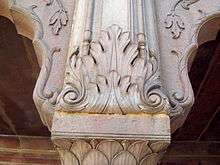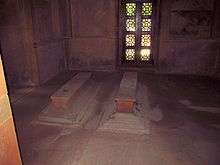Lal Bangla
Lal Bangla are two imperial late-Mughal mausoleums located in Delhi, India, that are that protected monument under the Archaeological Survey of India.[1]


Overview
Lal Bangla consists of two tombs made out of red and yellow sandstone. One of the tombs contains two graves, believed to be that of Lal Kunwar, the mother of Shah Alam II (1759-1806) and Begum Jaan, his daughter.
Both mausoleums consist of square rooms at diagonals with oblong halls between them. The mausoleum stands on a red sandstone platform with rooms at corners. The dome of the mausoleum is in the late Mughal style and has a pinnacle at the top. The mausoleums share architectural similarities with the use of red and yellow sandstone of the Tomb of Safdarjung.
The adjoining enclosure has three tombs belong to the family of emperor Akbar II (1806-1837). The buildings are within the premises of the Delhi Golf Club.
Also located within the complex is the tomb of Syed Abid, which was built in 1036 AH ( approx. 1626 CE). Sir Syed Ahmed Khan's seminal work on the monuments of Delhi, Aasar Us Sanaadeed mentions Syed Abid as an associate of Khan Dauran Khan, one of Shahjahan's leading soldiers.
See also
- List of Monuments of National Importance in Delhi
- Tomb of Mariam-uz-Zamani, resting place of Empress Mariam uz-Zamani, consort of Emperor Akbar
- Tomb of Nur Jahan in Lahore, resting place of Empress Nur Jahan, consort of Emperor Jahangir
- Roshanara Bagh in Delhi, resting place of Roshanara Begum, second daughter of the Emperor Shah Jahan
References
External links
![]()